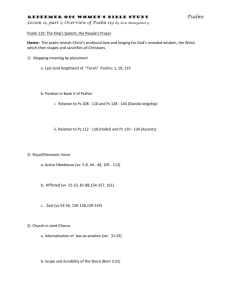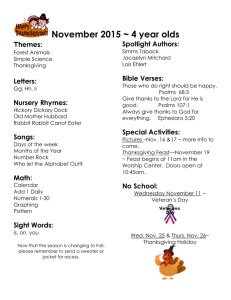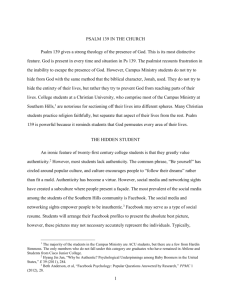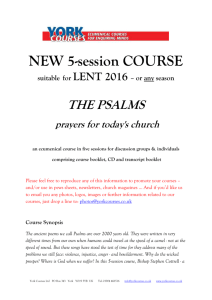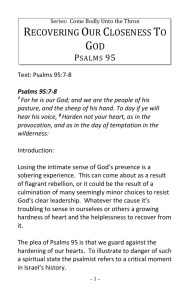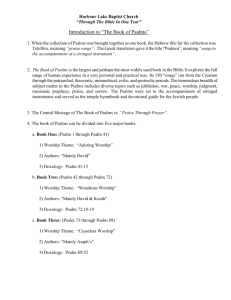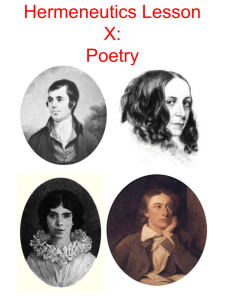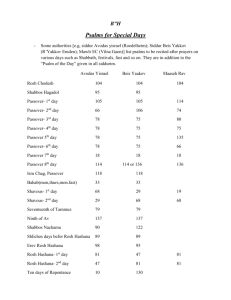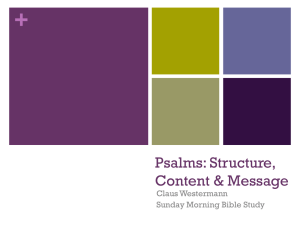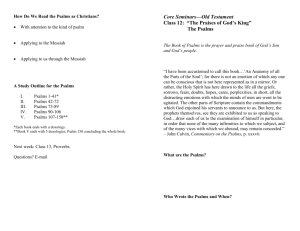How To Read Psalms
advertisement
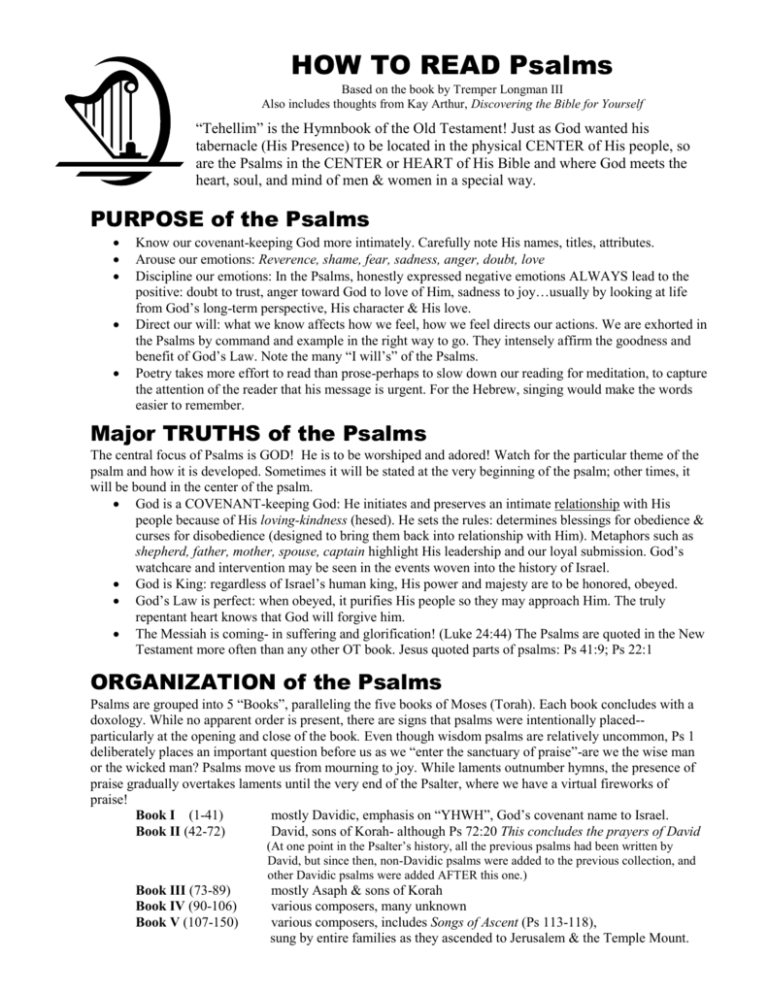
HOW TO READ Psalms Based on the book by Tremper Longman III Also includes thoughts from Kay Arthur, Discovering the Bible for Yourself “Tehellim” is the Hymnbook of the Old Testament! Just as God wanted his tabernacle (His Presence) to be located in the physical CENTER of His people, so are the Psalms in the CENTER or HEART of His Bible and where God meets the heart, soul, and mind of men & women in a special way. PURPOSE of the Psalms Know our covenant-keeping God more intimately. Carefully note His names, titles, attributes. Arouse our emotions: Reverence, shame, fear, sadness, anger, doubt, love Discipline our emotions: In the Psalms, honestly expressed negative emotions ALWAYS lead to the positive: doubt to trust, anger toward God to love of Him, sadness to joy…usually by looking at life from God’s long-term perspective, His character & His love. Direct our will: what we know affects how we feel, how we feel directs our actions. We are exhorted in the Psalms by command and example in the right way to go. They intensely affirm the goodness and benefit of God’s Law. Note the many “I will’s” of the Psalms. Poetry takes more effort to read than prose-perhaps to slow down our reading for meditation, to capture the attention of the reader that his message is urgent. For the Hebrew, singing would make the words easier to remember. Major TRUTHS of the Psalms The central focus of Psalms is GOD! He is to be worshiped and adored! Watch for the particular theme of the psalm and how it is developed. Sometimes it will be stated at the very beginning of the psalm; other times, it will be bound in the center of the psalm. God is a COVENANT-keeping God: He initiates and preserves an intimate relationship with His people because of His loving-kindness (hesed). He sets the rules: determines blessings for obedience & curses for disobedience (designed to bring them back into relationship with Him). Metaphors such as shepherd, father, mother, spouse, captain highlight His leadership and our loyal submission. God’s watchcare and intervention may be seen in the events woven into the history of Israel. God is King: regardless of Israel’s human king, His power and majesty are to be honored, obeyed. God’s Law is perfect: when obeyed, it purifies His people so they may approach Him. The truly repentant heart knows that God will forgive him. The Messiah is coming- in suffering and glorification! (Luke 24:44) The Psalms are quoted in the New Testament more often than any other OT book. Jesus quoted parts of psalms: Ps 41:9; Ps 22:1 ORGANIZATION of the Psalms Psalms are grouped into 5 “Books”, paralleling the five books of Moses (Torah). Each book concludes with a doxology. While no apparent order is present, there are signs that psalms were intentionally placed-particularly at the opening and close of the book. Even though wisdom psalms are relatively uncommon, Ps 1 deliberately places an important question before us as we “enter the sanctuary of praise”-are we the wise man or the wicked man? Psalms move us from mourning to joy. While laments outnumber hymns, the presence of praise gradually overtakes laments until the very end of the Psalter, where we have a virtual fireworks of praise! Book I (1-41) mostly Davidic, emphasis on “YHWH”, God’s covenant name to Israel. Book II (42-72) David, sons of Korah- although Ps 72:20 This concludes the prayers of David (At one point in the Psalter’s history, all the previous psalms had been written by David, but since then, non-Davidic psalms were added to the previous collection, and other Davidic psalms were added AFTER this one.) Book III (73-89) Book IV (90-106) Book V (107-150) mostly Asaph & sons of Korah various composers, many unknown various composers, includes Songs of Ascent (Ps 113-118), sung by entire families as they ascended to Jerusalem & the Temple Mount. …Be filled with the Spirit, speaking to one another in psalms and hymns and spiritual songs, singing and making melody with your heart to the Lord Ephesians 5:18-19 7 TYPES of PSALMS Note: A psalm may fit under more than one genre. 1. The HYMN: Begins with a call to worship God. Look for the reasons for praise: Creator, Mt Zion b/c God has caused His presence to dwell there, etc. Includes hymns of Deliverance 2. The LAMENT: polar opposite of “hymn”, defined by its mood. Cry of great distress, nowhere to turn but God. Complaints may be caused by his own thoughts and actions, the actions of others against him, or frustrated by God himself. Honest with God about his needs, he usually declares his basic trust in God. Holding nothing back, he sometimes curses his enemies (imprecation). He may confess his sin or protest his innocence. In most cases, sorrow turns to joy. Is it the cry of an individual or a community? 3. THANKSGIVING Psalms: Expressions of gratitude for answered prayer. Begins in similar way to a HYMN. Note: What is the LAMENT which is now answered? 4. Psalms of CONFIDENCE in GOD’s goodness and power. What is the metaphor he uses to praise God? (refuge, shepherd, light, rock, help, etc). Expresses submissive trust in God. 5. Psalms of REMEMBERANCE: God’s great redemptive acts such as the Exodus, Davidic covenant. 6. WISDOM Psalms: Psalms provide practical counsel for living, understanding. Contrasts ways of living (wise & foolish) which bring about different consequences. Ps 119 extols the blessings of God’s Law. 7. KINGSHIP Psalms: focuses on either the human king of Israel or on the fact that God is the true King of all the earth. Note: Is the king the speaker or the object of prayer? TITLES of the Psalms Rabbis consider “titles” to be the first verse of the psalm. These introductions provide information about its origin such as author, historical occasion which prompted its writing, its function, audience, or melody. Composer: The Psalter was written by many authors over a period of 1,000 years--From Moses to David, Solomon, Moses, sons of Korah, sons of Asaph, and even from the “post-exilic” period. Some are “orphan psalms” (author unnamed). Note that “a psalm of David can also mean, “to” David, “for” David, or written in a style “like” David. Sometimes, it is thought that a psalm written by David may have been “updated” by other writers to reflect a more current period, like Ps 51:18-19 & Ps 69:35-36 which may have been post-exilic prayers added to David’s original psalm. Some psalms were well-known before David’s time, such as Ps 113, parts of which were sung by Hannah as she dedicated her son, Samuel, to the LORD. History: Most psalms are relevant to all people of all ages. However, historical titles may pinpoint the event which inspired the writing. Only 14 psalms note the circumstance (Ps 3, 7, 18, 30, 34, 51, 52, 54, 56, 57, 59, 60, 63, 142)- all of which involved David. Note the cross-reference to the historical book in your Bible and read it. Scholars note that more historical titles were added as the years passed. The shift from first person to third person suggests that someone other than David may have added these titles. Sometimes the title does not fit with the content of the psalm (Ps 3, 30)..It is best to consider the titles non-canonical, but mostly reliable early tradition-not bending the psalm’s interpretation unnaturally to fit its title. Glossary of Musical or Hebrew Terms Selah: Crescendo or musical interlude. Pause and think upon what you have just sung Maskil: Teaching psalm. Note the parts which are instructive. Mitham: Thoughts that ought to be “carved” into your heart. Sheol: the comfortable realm of the righteous dead, before Messiah took their souls to heaven. (Eph 4:8) Consider ending each day with a Psalm of Praise! For the Lord takes pleasure in His people; He will beautify the afflicted ones with salvation. Let the godly ones exult in glory; Let them sing for joy on their beds. Psalm 149:4-5 How to Read Hebrew Poetry Parallelism refers to the correspondence between the phrases of a poetic line. One complete parallelism is called a line. Each line will contain two or more poetic phrases or colons (cola). A line may be bi-colon, tri-colon, (occasionally, mono-colon). The first colon is referred to as “A”, the second,”B”, etc. The second phrase usually carries the first thought forward in a more detailed way. Today’s understood pattern of interpretation is “A, what’s more B”. Observe how the phrases relate to one another, what the line as a whole means. Sometimes well-meaning English translations obscure the style, meaning of Hebrew poetry. SYNONYMOUS PARALLELISM compares thoughts, A=B, such as Ps 2 ANTITHETICAL PARALLELISM: A=B, but uses words of opposite meaning, Prov 10:1 SYNTHETIC PARALLELISM: second phrase supplements the first, Ps 2:6 or denotes a cause and effect relationship, Ps 23:1. EMBLEMATIC PARALLELISM: draws an analogy using words of comparison (like, as) Ps 42:1 REPETITIVE PARALLELISM: stepladder, staricase or climactic parallelism. Ps 29:1 PIVOT PATTERN: a single word or clause stands in the middle of the line, but should be read with both phrases (to the nations in Ps 98:2; I will fear no evil in Ps 23:4) CHIASM: from the Greek letter chi (large X), reflects the diagram of comparing words/ phrases. Ps 1:6 For the LORD watches over the way of the righteous A B B A But the way of the wicked will perish GRAMMATICAL PARALLELISM; a different order of the parts of speech aid in avoiding monotony as thoughts are repeated. This feature is sometimes lost or “corrected” in English translations. ELLIPSIS: sometimes a verb is omitted from the second phrase in order to bind the two thoughts more closely together, Ps 88.6 Other Poetic Devices: Ancient Hebrew poets “beautified” their works in other interesting, notable ways. INCLUSIO: repeats thoughts, not between phrases in a line, but to open and close a poem. Ps 8:1, 9. While it gives the poem a sense of closure, it also imparts a sense of unity, and sets the mood for the whole psalm. ACROSTIC: the first letter of each line forms a recognizable pattern. While some ancient Babylonian poems spell out the name of the scribe or a hidden message, Hebrew poetry follows the order of its alphabet. In the “Giant Psalm”, Ps 119, each stanza has 8 lines with begin with the same letter of the alphabet.. Other psalms devote just one line or a single phrase to a letter, (Ps 9, 10, 25, 34, 111, 112, 119, 145). Perhaps this is a formal way of reflecting their trust that God gave order to His creation. More likely, they are a device to aid memorization or were simply aesthetically pleasing. Perhaps the additional word-choice restrictions made composition more difficult and thus made the end product all the more exciting to produce and read. IMAGERY: The rich pictures in Hebrew writing surprise us, cause us to take notice, Ps 127:3-5: sons compared to arrows (arrows belong to a warrior, aid him in battle, source of strength and victory). A picture is indeed “worth a thousand words”. Typically found in personifications, similies, metaphors. Understanding Hebrew imagery is sometimes made a little more complicated because it is based on things that would be familiar to a foreign, ancient culture (shepherds). Sometimes it requires understanding the mythology of a pagan religion of Israel’s neighbors (Leviathan, Ps 74) or the geography of the land (Ps 48). While commentaries are the best means for learning about the background of the Psalms, they must be read with a critical mind and ONLY after you have first carefully observed the Psalm yourself. METER: is a patterned rhythm that structures a whole poem. Most English and classical poems are structured by meter. However, recent research (bef. 1988) has concluded that the biblical Psalms are NOT metrical. Therefore, ignore any “interpretation” that is based on meter. Recommended Commentaries Allen, L.C. Psalms 100-150 Word Biblical Commentary 21. Admirable job of discussing the meaning of the psalm within its OT context. One of the better commentaries on the Psalms available to the evangelical. Craigie, P.C. Psalms 1-50 Word Biblical Commentary 19. Perhaps the best scholarly commentary available to the evangelical world. Regrettable that it only covers the first 50 psalms. Strong in getting to the meaning of the Psalms in their OT context. Weak in connecting the psalm to the coming of Jesus and in its daily application. Kidner, D. Psalms. 2 vols. (1973-74) Comments are brief, but clear and packed with insight.
